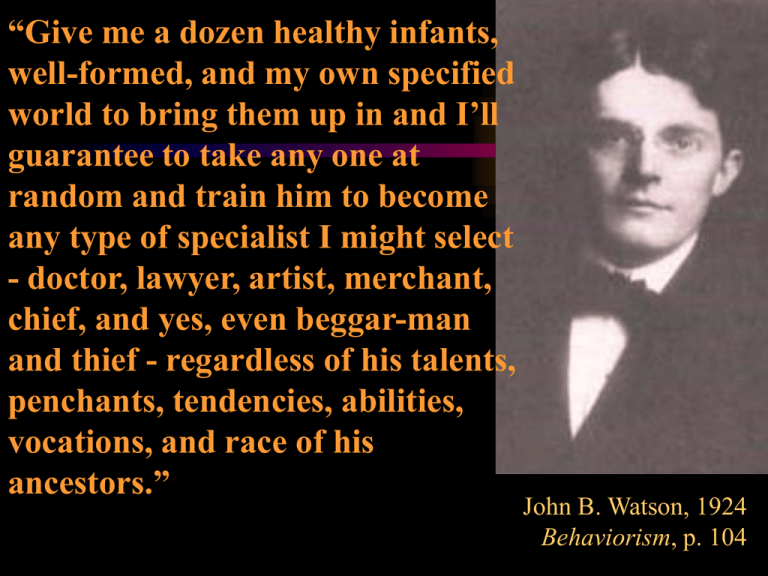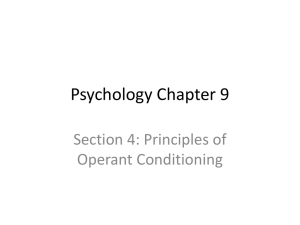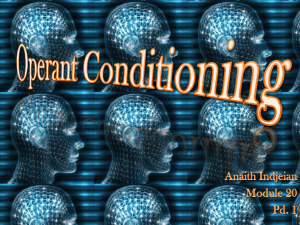Pavlov, Watson, and Skinner
advertisement

“Give me a dozen healthy infants, well-formed, and my own specified world to bring them up in and I’ll guarantee to take any one at random and train him to become any type of specialist I might select - doctor, lawyer, artist, merchant, chief, and yes, even beggar-man and thief - regardless of his talents, penchants, tendencies, abilities, vocations, and race of his ancestors.” John B. Watson, 1924 Behaviorism, p. 104 BEHAVIORISM BEHAVIORISM ENVIRONMENT Stimulus BEHAVIOR Response MEDIATING MECHANISMS • Nature of the association (pairing) IVAN PAVLOV CLASSICAL CONDITIONING RESPONDENT CONDITIONING RESPONDENT BEHAVIOR IS A PHYSIOLOGICAL OR EMOTIONAL RESPONSE ELICITED BY A STIMULUS UCS elicits UCR Neutral stimulus and UCS paired (association is attempted) Neutral stimulus becomes CS that elicits Conditioned Response (association is made) BEHAVIORISM ENVIRONMENT Stimulus BEHAVIOR Response MEDIATING MECHANISMS • Nature of the association (pairing) • Nature of reinforcement B. F. SKINNER OPERANT CONDITIONING OPERANT BEHAVIORS ARE ACTIONS THAT INDIVIDUALS TAKE TO MEET THE DEMANDS OF THEIR ENVIRONMENTS TYPE S CONDITIONING (RESPONDENT) SD R TYPE R CONDITIONING (OPERANT) S D TEACHER ASKS QUESTION R STUDENT RAISES HAND S R TEACHER SAYS “AN A FOR YOU!” REINFORCEMENT Any event following a behavior that increases the likelihood of that behavior occurring again. “The only defining characteristic of a reinforcing stimulus is that it reinforces” (Skinner, 1953, p. 72). OPERANT CONDITIONING TECHNIQUES • POSITIVE REINFORCEMENT = increasing a behavior by administering a reward • NEGATIVE REINFORCEMENT = increasing a behavior by removing an aversive stimulus when a behavior occurs • PUNISHMENT = decreasing a behavior by administering an aversive stimulus following a behavior OR by removing a positive stimulus • EXTINCTION = decreasing a behavior by not rewarding it LIMITED EFFECTS OF PUNISHMENT • • • • Punishment does not teach appropriate behaviors Must be delivered immediately & consistently May result in negative side effects Undesirable behaviors may be learned through modeling (aggression) • May create negative emotions (anxiety & fear) BEHAVIORISM ENVIRONMENT Stimulus BEHAVIOR Response MEDIATING MECHANISMS • Nature of the association (pairing) • Nature of reinforcement • Schedules of reinforcement FIXED VARIABLE SCHEDULES OF REINFORCEMENT CONTINUOUS or INTERMITTENT RATIO INTERVAL SCHEDULES OF REINFORCEMENT • Interval schedules: reinforcement occurs after a certain amount of time has passed • Fixed Interval = reinforcement is presented after a fixed amount of time • Variable Interval = reinforcement is delivered on a random/variable time schedule • Ratio schedules: reinforcement occurs after a certain number of responses • Fixed Ratio = reinforcement presented after a fixed # of responses • Variable Ratio = reinforcement delivery is variable but based on an overall average # of responses BEHAVIORISM ENVIRONMENT Stimulus BEHAVIOR Response MEDIATING MECHANISMS • Nature of the association (pairing) • Nature of reinforcement (stimulus) • Schedules of reinforcement • Shaping (successive approximations) HOW COMPLEX BEHAVIORS ARE LEARNED • Successive approximation/shaping = reinforcing behaviors as they come to approximate the desired behavior • Superstitious Behavior = when persistent behaviors are reinforced coincidentally rather than functionally • Self-control of behavior Stimulus avoidance Self-administered satiation Aversive stimulation Self-reinforcement B. F. Skinner Aircribs and teaching machines 1945: aircrib Teaching machine invented in the 1920s by Pressey promoted by Skinner 1968: The Technology of Teaching B. F. Skinner Walden Two (1948): A behavioristic society Program of behavioral control A technology of behavior Application of laboratory findings to society at large “If the occurrence of an operant is followed by presentation of a reinforcing stimulus, the strength is increased . . . if the occurrence of an operant already strengthened through conditioning is not followed by the reinforcing stimulus, the strength is decreased.” B. F. Skinner Behavior modification Used in a variety of applied settings Reinforce desired behavior and extinguish undesired behavior Punishment is not used BEHAVIOR MODIFICATION Central Human Motive in Skinner’s Theory Environmental consequences shape behavior Skinner’s Theory “All we need to know in order to describe and explain behavior is this: actions followed by good outcomes are likely to recur , and actions followed by bad outcomes are less likely to recur.” (Skinner, 1953) B. F. Skinner Criticisms of Skinner’s behaviorism His extreme positivism His opposition to theory His willingness to extrapolate beyond the data The narrow range of behavior studied Problem of instinctive drift His position on verbal behavior B. F. Skinner Contributions of Skinner’s behaviorism Shaped American psychology for 30 years His goal: the improvement of society Srength and ramifications of his radical behaviorism “The goal of psychology should be the prediction and control of behavior.” John B. Watson, 1913 Psychology as the Behaviorist Views It, p. 158 John Watson on Children: “Never hug and kiss them, never let them sit on your lap. If you must, kiss them once on the forehead when they say good night. Shake hands with them in the morning. Give them a pat on the head if they have made an extraordinarily good job of a difficult task. Try it out. In a week's time you will find how easy it is to be perfectly objective with your child and at the same time kindly. You will be utterly ashamed of the mawkish, sentimental way you have been handling it.”







